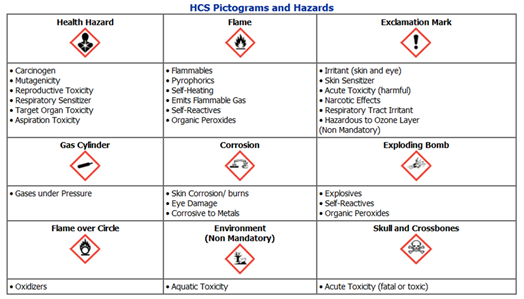By: Chris Hall
Recent changes in OSHA’s Hazard Communication Standard have finalized its alignment with the United Nations’ Globally Harmonized System of Classification and Labeling of Chemicals (GHS). The updated regulations will change the way that manufacturers and importers label chemical containers and how their MSDS’s will be formatted. The new system will also outline specific criteria for the classification of health and physical hazards. All of these changes will affect the front line employee using the products and employers will be required to train those workers on the changes by December 2013.
OSHA’s change to the GHS has been in the works for several years. In 2003 the UN endorsed the GHS as a means to bring the world community in alignment with one system of chemical classifications, labeling, and documentation formatting. The changes have been analyzed by OSHA and determined that once fully implemented, it will reduce workplace exposures to hazardous chemicals and save employers money through enhanced productivity and lower incident rates.
The four major changes to the standard deal with classification of hazards, container labeling, formatting of MSDS’s (now called SDS’s), and training for workers on the changes.
Hazard Classification
Chemical hazards will now have a uniform hazard classification that is utilized for all organizations adopting the GHS. This will change the classification of specific chemical products, now that the system is altered. A good example is the organization of flammable liquids. OSHA’s classification for flammable liquids was previously capped at a flash point of 100° F. With the new changes, the flash point for flammable liquids will be extended to 140° F, which will then cause many chemical products previously considered “combustible” to be reclassified as flammable.

Container Labels
Chemical labels will now be required to be standardized to include a harmonized signal word, a pictogram, and hazard statements for each hazard class and category. Precaution statements will also accompany the product information.
Safety Data Sheets
New formatting for Material Safety Data Sheets (MSDS) will require that they are all in a 16 part format. They will also be referred to as Safety Data Sheets (SDS). For many chemical manufacturers, this new format has already been adopted and sheets are currently in compliance. Companies will have to eventually update their programs and sheets to meet the new GHS standard.
Information and Training
OSHA has provided a time frame for training employees to understand the new labeling system and SDS forms. This training must be completed by December 1, 2013. Employees must be able to understand the pictograms and hazard statements, but also the changes in some the chemical classifications that will occur with products in use. If the employer is going to continue using their own labeling system for secondary containers (such as NFPA diamond or HMIS), they must adjust labels for new classifications and ensure employees understand both the new GHS and old system labels.
The new changes to OSHA’s Hazard Communication Standard will affect all employers using hazardous chemicals in the workplace. It is their responsibility to make sure employees understand the changes and work within the new guidelines. Over the next few years OSHA anticipates seeing an increase in “adjustment” costs for employers, but it will ultimately be returned in the form of cost savings and reduced injury rates.
Related Topics: OSHA Hazard Communication Standard, Globally Harmonized System of Classification and Labeling of Chemicals, GHS, Safety Articles, Monthly Safety Topics